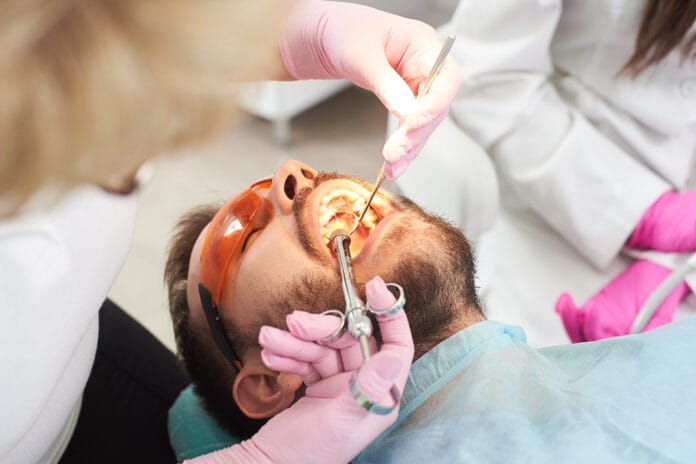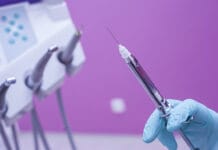Disclosure: This article is sponsored content from Septodont as part of our sponsored partner program.
During my early years in dentistry, I was a dental assistant before going to dental hygiene school. I have a distinct memory that is seared into my brain of a child around five years old who had restorative work completed only to return the next day with a swollen lip and ulcerated areas on his lip as well as his tongue. Though the dentists and I had emphatically expressed the importance of watching the child to ensure he did not chew on his lip or tongue, it still occurred.
This was the mid-1990s, well before any options existed other than just watching the child closely. Times have changed, and science has advanced to provide us with the tools to prevent such situations. Reversal agents such as phentolamine mesylate, which is the active ingredient in OraVerse® by Septodont, are a good option for situations like this.
Phentolamine mesylate is a nonselective alpha-adrenergic antagonist. It’s an injectable medication used for hypertension and hypertensive emergencies as well as vasospasms associated with Raynaud’s syndrome and frostbite.1 It also represents a new class of drugs used in dentistry for the reversal of soft tissue anesthesia. In a survey answered by 200 patients, 122 wanted to reverse the effects of the local anesthesia. This survey indicated use of a local anesthesia reversal agent such as OraVerse® would be of interest to patients.2
Benefits to Dental Practices and Patients
In clinical trials, participants received a mandibular or maxillary injection of 1.8 mL of 2% lidocaine with 1:100,000 epinephrine, followed by the same amount of OraVerse®. The data indicated the median time it took to return to normal sensation after the OraVerse® injection was reduced by 85 minutes for normal lower-lip sensations, 82.5 minutes for normal upper-lip sensations, 65 minutes for normal tongue sensations, and 60 minutes for recovery of normal function (smiling, speaking, drinking, and absence of drooling), versus the placebo.3-4 In a separate peer-reviewed study, the dentists that participated in collecting the data within their practice reported OraVerse® addressed “an existing need (86%), met expectations (82%), was a practice differentiator (55%), a practice builder (45%), and improved scheduling (29%).”5
The safety and efficacy of OraVerse® have been well established in multiple studies, including for pediatric patients (age three and over), adolescents, and adults.6-8 The use of a local anesthetic reversal agent may improve the patient’s lifestyle after dental treatment. Potential candidates for the use of OraVerse® include pediatric, geriatric, special needs, and medically compromised patients. Reversal of the local anesthesia can reduce traumatic injuries and allow safe eating and clearer speaking. Eating can be imperative for diabetic patients who are managing their blood glucose levels, which may complicate their ability to schedule treatment. Offering a reversal agent may encourage the patient to make appointments for restorative treatment as it will reduce the time in which their ability to eat is compromised.
The same concept is true for working professionals who need to be able to speak clearly at meetings. If patients can take a small fraction of their day to commit to dental treatment and the effects of local anesthesia, rather than experience numbness and the inability to speak clearly for hours, then that may be the encouragement they need to follow through with restorative or nonsurgical periodontal treatment they have been putting off.
Adverse Reactions
It should be noted that with any drug, adverse reactions may occur. In clinical trials, the most common adverse events with OraVerse® (phentolamine mesylate) vs. control were post-procedural pain (6% vs. 6%), injection site pain (5% vs. 4%), tachycardia (5% vs. 6%), bradycardia (2% vs. 0.3%) and headache (3% vs. 4%). Following parenteral use of phentolamine in non-dental indications, myocardial infarction and cerebrovascular spasm and occlusion have been reported, usually in association with marked hypotensive episodes producing shock-like states.
Although such effects are uncommon with OraVerse®, clinicians should be alert to the signs and symptoms of tachycardia and cardiac arrhythmias, particularly in patients with a history of cardiovascular disease, as these symptoms may occur with the use of phentolamine or other alpha-adrenergic blocking agents.
In Closing
In recent years in my clinical practices, patients have inquired more frequently about local anesthesia reversal agents ‒ many simply because they hate “feeling numb.” Even though the Food and Drug Administration approved OraVerse® in 2008,9 dental practices that offer local anesthesia reversal agents are still too few. I would encourage all dental professionals to consider offering this as an option for patients who are considering conservative dental treatment as well as non-surgical periodontal therapy.
For more information about OraVerse®, click here. For important safety information and to view the package insert, click here.
References
- Phentolamine mesylate. (n.d.). National Library of Medicine. National Center for Biotechnology Information. https://pubchem.ncbi.nlm.nih.gov/compound/Phentolamine-mesylate
- Shetty, C., Devanathan, N., Shetty, A., et al. Phentolamine mesylate as a drug for reversal of local anaesthesia – a questionnaire-based study. J Evolution Med Dent Sci. 2020; 9(43): 3227-3230, DOI: 10.14260/jemds/2020/708. https://www.jemds.com/data_pdf/Nikhita%20Devanathan,%20Issue%2043,%20Oct%2026,%202020..pdf
- Rutherford, B.A. Phase 3, Multicenter, Randomized, Blinded, Controlled Study of NV-101 for Efficacy, Pharmacodynamics and Safety in Dental Patients Undergoing Maxillary Procedures. Clin Res. 2006; 60: eCTD 0000 M5.3.5.1 NOVA-04-200.
- Rutherford, B.A. Phase 3, Multicenter, Randomized, Blinded, Controlled Study of NV-101 for Efficacy, Pharmacodynamics and Safety in Dental Patients Undergoing Mandibular Procedures. Clin Res. 2006; 77: eCTD 0000 M5.3.5.1 NOVA-04-100.
- Saunders, T.R., Psaltis, G., Weston, J.F., et al. In-practice evaluation of OraVerse for the reversal of soft-tissue anesthesia after dental procedures. Compend Contin Educ Dent. 2011; 32(5): 58-62. https://pubmed.ncbi.nlm.nih.gov/21755896/
- Hersh, E.V., Lindemeyer, R., Berg, J.H., et al. Phase Four, Randomized, Double-Blinded, Controlled Trial of Phentolamine Mesylate in Two- to Five-year-old Dental Patients. Pediatr Dent. 2017; 39(1): 39-45. https://pubmed.ncbi.nlm.nih.gov/28292340/
- Hersh, E.V., Moore, P.A., Papas, A.S., et al. Reversal of soft-tissue local anesthesia with phentolamine mesylate in adolescents and adults. J Am Dent Assoc. 2008; 139(8): 1080-1093. doi:10.14219/jada.archive.2008.0311. https://pubmed.ncbi.nlm.nih.gov/18682623/
- Tavares, M., Goodson, J.M., Studen-Pavlovich, D, et al. Reversal of soft-tissue local anesthesia with phentolamine mesylate in pediatric patients [published correction appears in J Am Dent Assoc. 2008 Oct;139(10):1312]. J Am Dent Assoc. 2008; 139(8): 1095-1104. doi:10.14219/jada.archive.2008.0312. https://pubmed.ncbi.nlm.nih.gov/18682624/
- Pediatric Postmarketing Pharmacovigilance Review. (2018). Food and Drug Administration. https://fda.report/media/116025/Oraverse+Safety+Review_UCM620258_508ed.pdf












